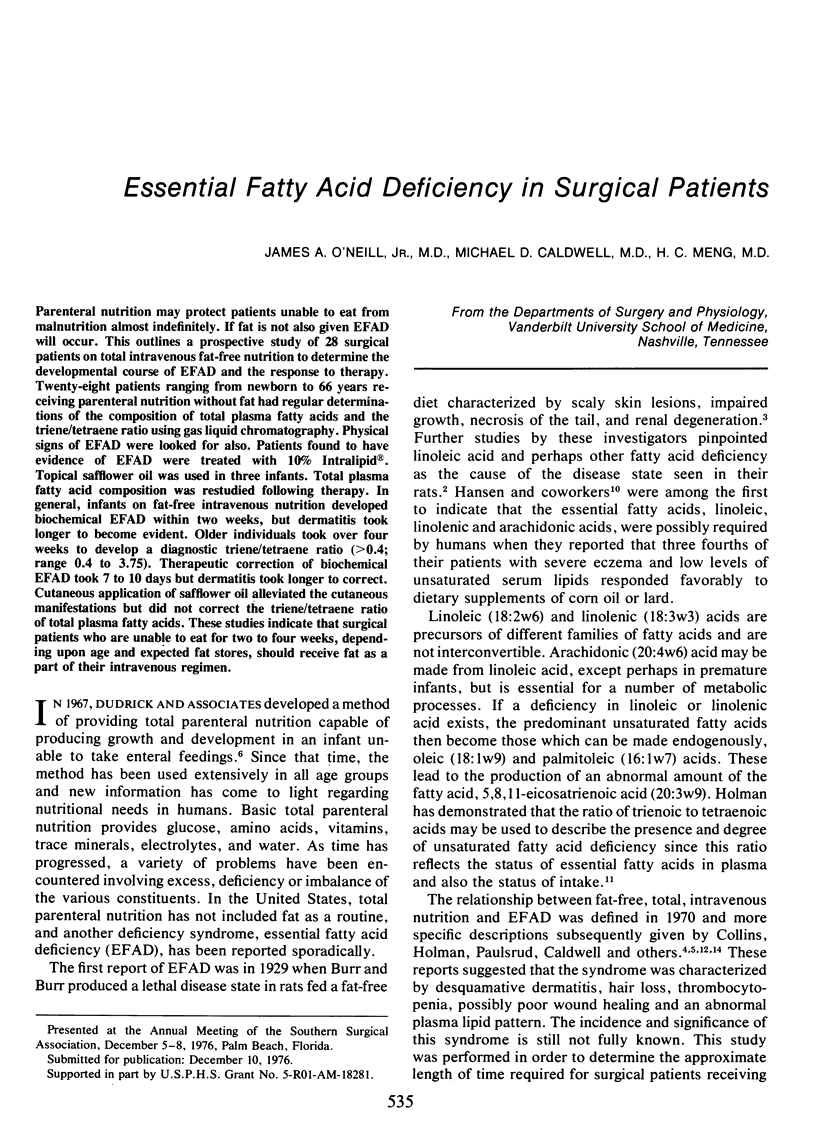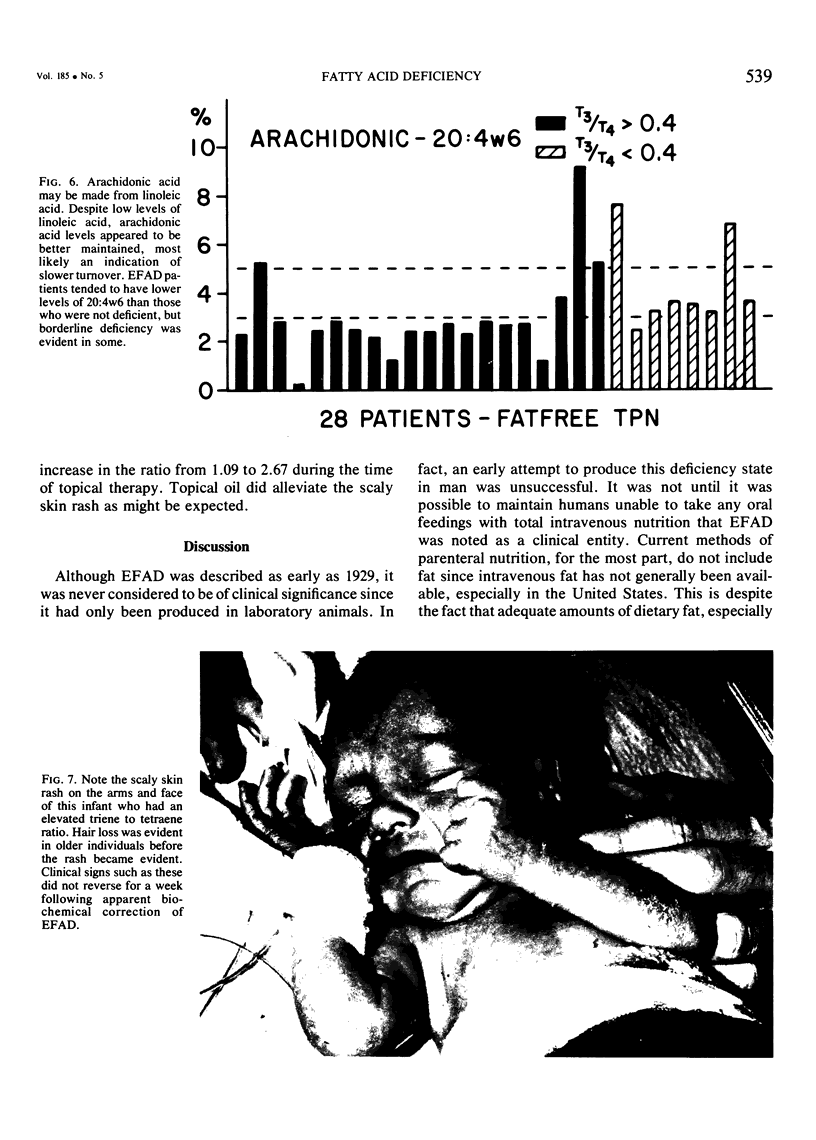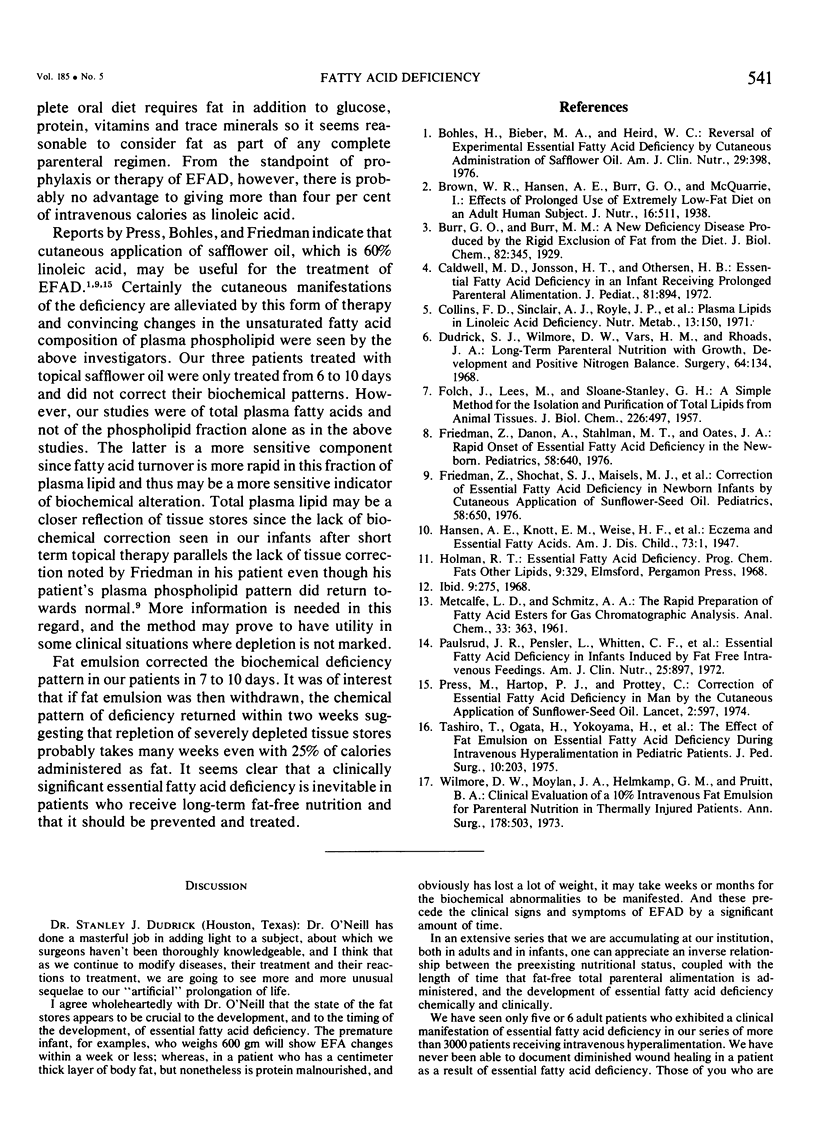Abstract
Parenteral nutrition may protect patients unable to eat from malnutrition almost indefinitely. If fat is not also given EFAD will occur. This outlines a prospective study of 28 surgical patients on total intravenous fat-free nutrition to determine the developmental course of EFAD and the response to therapy. Twenty-eight patients ranging from newborn to 66 years receiving parenteral nutrition without fat had regular determinations of the composition of total plasma fatty acids and the triene/tetraene ratio using gas liquid chromatography. Physical signs of EFAD were looked for also. Patients found to have evidence of EFAD were treated with 10% Intralipid. Topical safflower oil was used in three infants. Total plasma fatty acid composition was restudied following therapy. In general, infants on fat-free intravenous nutrition developed biochemical EFAD within two weeks, but dermatitis took longer to become evident. Older individuals took over four weeks to develop a diagnostic triene/tetraene ratio (greater than 0.4; range 0.4 to 3.75). Therapeutic correction of biochemical EFAD took 7 to 10 days but dermatitis took longer to correct. Cutaneous application of safflower oil alleviated the cutaneous manifestations but did not correct the triene/tetraene ratio of total plasma fatty acids. These studies indicate that surgical patients who are unable to eat for two to four weeks, depending upon age and expected fat stores, should receive fat as a part of their intravenous regimen.
Full text
PDF






Images in this article
Selected References
These references are in PubMed. This may not be the complete list of references from this article.
- Böhles H., Bieber M. A., Heird W. C. Reversal of experimental essential fatty acid deficiency by cutaneous administration of safflower oil. Am J Clin Nutr. 1976 Apr;29(4):398–401. doi: 10.1093/ajcn/29.4.398. [DOI] [PubMed] [Google Scholar]
- Caldwell M. D., Jonsson H. T., Othersen H. B., Jr Essential fatty acid deficiency in an infant receiving prolonged parenteral alimentation. J Pediatr. 1972 Nov;81(5):894–898. doi: 10.1016/s0022-3476(72)80539-0. [DOI] [PubMed] [Google Scholar]
- Collins F. D., Sinclair A. J., Royle J. P., Coats D. A., Maynard A. T., Leonard R. F. Plasma lipids in human linoleic acid deficiency. Nutr Metab. 1971;13(3):150–167. doi: 10.1159/000175332. [DOI] [PubMed] [Google Scholar]
- Dudrick S. J., Wilmore D. W., Vars H. M., Rhoads J. E. Long-term total parenteral nutrition with growth, development, and positive nitrogen balance. Surgery. 1968 Jul;64(1):134–142. [PubMed] [Google Scholar]
- FOLCH J., LEES M., SLOANE STANLEY G. H. A simple method for the isolation and purification of total lipides from animal tissues. J Biol Chem. 1957 May;226(1):497–509. [PubMed] [Google Scholar]
- Friedman Z., Danon A., Stahlman M. T., Oates J. A. Rapid onset of essential fatty acid deficiency in the newborn. Pediatrics. 1976 Nov;58(5):640–649. [PubMed] [Google Scholar]
- Friedman Z., Shochat S. J., Maisels M. J., Marks K. H., Lamberth E. L., Jr Correction of essential fatty acid deficiency in newborn infants by cutaneous application of sunflower-seed oil. Pediatrics. 1976 Nov;58(5):650–654. [PubMed] [Google Scholar]
- Paulsrud J. R., Pensler L., Whitten C. F., Stewart S., Holman R. T. Essential fatty acid deficiency in infants induced by fat-free intravenous feeding. Am J Clin Nutr. 1972 Sep;25(9):897–904. doi: 10.1093/ajcn/25.9.897. [DOI] [PubMed] [Google Scholar]
- Press M., Hartop P. J., Prottey C. Correction of essential fatty-acid deficiency in man by the cutaneous application of sunflower-seed oil. Lancet. 1974 Apr 6;1(7858):597–598. doi: 10.1016/s0140-6736(74)92653-1. [DOI] [PubMed] [Google Scholar]
- Tashiro T., Ogata H., Yokoyama H., Mashima Y., Iwasaki I. The effect of fat emulsion on essential fatty acid deficiency during intravenous hyperalimentation in pediatric patients. J Pediatr Surg. 1975 Apr;10(2):203–213. doi: 10.1016/0022-3468(75)90280-8. [DOI] [PubMed] [Google Scholar]
- Wilmore D. W., Moylan J. A., Helmkamp G. M., Pruitt B. A., Jr Clinical evaluation of a 10 percent intravenous fat emulsion for parenteral nutrition in thermally injured patients. Ann Surg. 1973 Oct;178(4):503–513. doi: 10.1097/00000658-197310000-00013. [DOI] [PMC free article] [PubMed] [Google Scholar]



